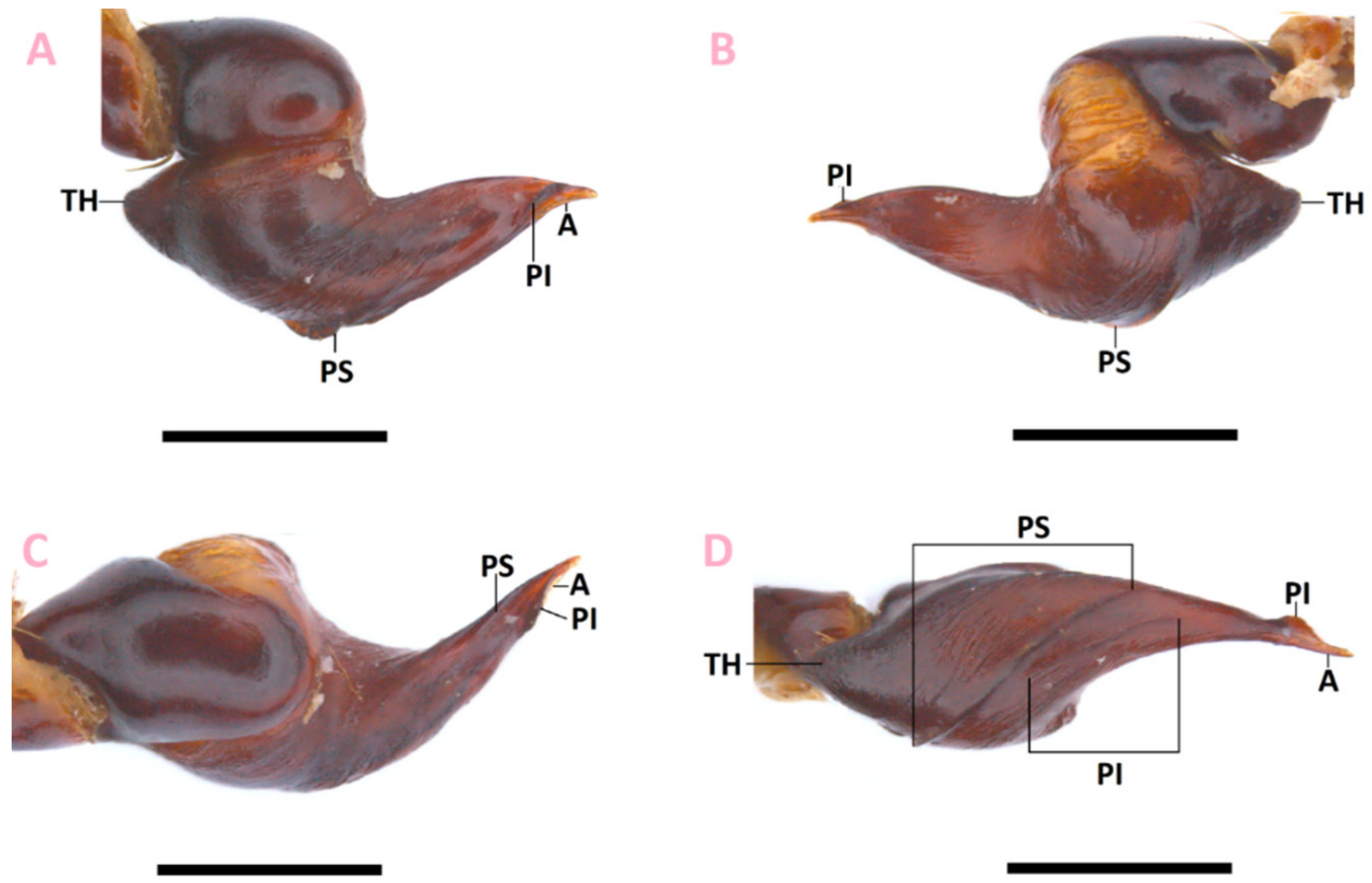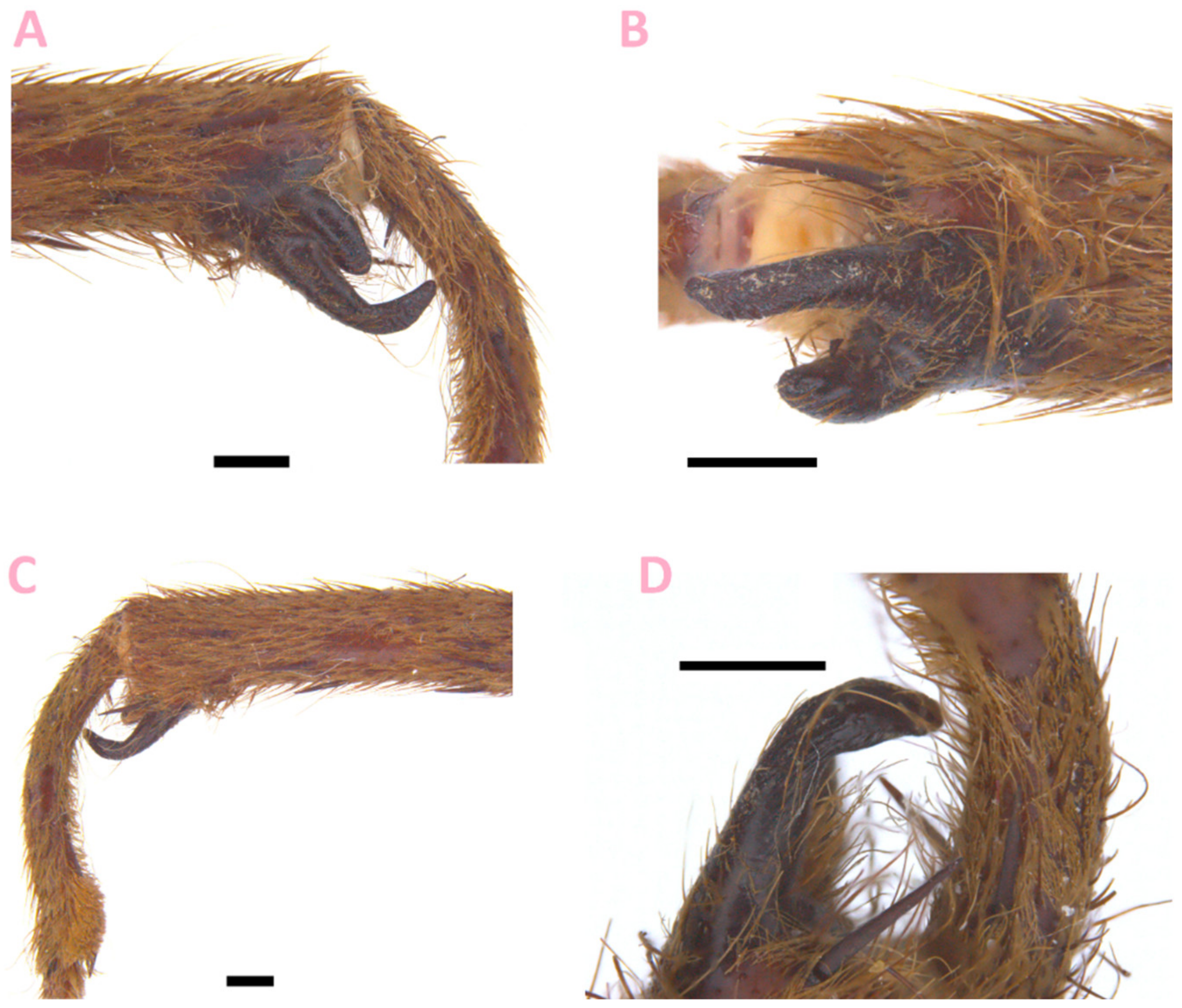Thrixopelma nadineae, a New Theraphosine from Ecuador (Araneae: Theraphosidae) †
Abstract
1. Introduction
2. Materials and Methods
3. Results
Thrixopelma nadineae sp. nov.
4. Discussion
Supplementary Materials
Author Contributions
Funding
Institutional Review Board Statement
Informed Consent Statement
Data Availability Statement
Acknowledgments
Conflicts of Interest
References
- World Spider Catalog. The World Spider Catalog, Version 23.0; Naturhistorisches Museum Bern: Bern, Switzerland, 2022. Available online: http://wsc.nmbe.ch (accessed on 23 April 2022).
- Sherwood, D.; Gabriel, R.; Kaderka, R.; Lucas, S.M.; Brescovit, A.D. Stabilizing a chaotic taxonomy: Redescription and redefinition of the genera Lasiodorides Schmidt & Bischoff, 1997 and Thrixopelma Schmidt, 1994 (Araneae: Theraphosidae). Arachnology 2021, 18, 893–917. [Google Scholar]
- Sherwood, D.; Fabiano-da-Silva, W.; Gabriel, R.; Lucas, S.M. Redescription of Nesipelma insulare Schmidt & Kovařík, 1996 with a revised generic diagnosis for Nesipelma Schmidt & Kovařík, 1996 and a transfer from Cyrtopholis Simon, 1892 (Araneae: Theraphosidae). Arachnology 2020, 18, 462–467. [Google Scholar]
- Evenhuis, N.L. The Insect and Spider Collections of the World; Bishop Museum: Honolulu, HI, USA, 1997; Available online: http://hbs.bishopmuseum.org/codens (accessed on 23 April 2022).
- Petrunkevitch, A. Arachnida from Panama. Trans. Connect. Acad. Arts Sci. 1925, 27, 51–248. [Google Scholar]
- Bertani, R. Revision, cladistic analysis, and zoogeography of Vitalius, Nhandu, and Proshapalopus; with notes on other theraphosine genera (Araneae, Theraphosidae). Arq. Zool. 2001, 36, 265–356. [Google Scholar]
- Bertani, R. Male palpal bulbs and homologous features in Theraphosinae (Araneae, Theraphosidae). J. Arachnol. 2000, 28, 29–42. [Google Scholar] [CrossRef]
- Gabriel, R. Revised taxonomic placement of the species in the Central American genera Davus O. Pickard-Cambridge, 1892, Metriopelma Becker, 1878, and Schizopelma F. O. Pickard-Cambridge, 1897, with comments on species in related genera (Araneae: Theraphosidae). Arachnology 2016, 17, 61–92. [Google Scholar] [CrossRef]
- Gabriel, R.; Sherwood, D. Revised taxonomic placement of Pseudhapalopus Strand, 1907, with notes on some related taxa (Araneae: Theraphosidae). Arachnology 2020, 18, 301–316. [Google Scholar] [CrossRef]
- Cooke, J.A.L.; Roth, V.D.; Miller, F.H. The urticating hairs of theraphosid spiders. Am. Mus. Novit. 1972, 2498, 1–43. [Google Scholar]
- Shorthouse, D.P. 2010: SimpleMappr, an online tool to produce publication-quality point maps. Available online: https://www.simplemappr.net (accessed on 23 April 2022).
- Dupérré, N.; Tapia, E. Megadiverse Ecuador: A review of Mysmenopsis (Araneae, Mysmenidae) of Ecuador, with the description of twenty-one new kleptoparasitic spider species. Zootaxa 2020, 4761, 1–81. [Google Scholar] [CrossRef] [PubMed]
- Dupérré, N.; Tapia, E.; Quandt, D.; Crespo-Pérez, V.; Harms, D. From the lowlands to the highlands of Ecuador, a study of the genus Masteria (Araneae, Mygalomorphae, Dipluridae) with description of seven new species. Zootaxa 2021, 5005, 538–568. [Google Scholar] [CrossRef] [PubMed]
- Allmon, W.D. The value of natural history collections. Curator 2001, 37, 83–89. [Google Scholar] [CrossRef]
- Bradley, R.D.; Bradley, L.C.; Garner, H.J.; Baker, R.J. Assessing the value of natural history collections and addressing issues regarding long-term growth and care. BioScience 2014, 64, 1150–1158. [Google Scholar] [CrossRef]
- Mares, M.A. Natural science collections: America’s irreplaceable resource. BioScience 2009, 59, 544–545. [Google Scholar] [CrossRef][Green Version]
- Nudds, J.R.; Pettitt, C.W. The Value and Valuation of Natural Science Collections, Proceedings of the International Conference, Manchester, UK, 1995; The Geological Society: London, UK, 1997; 276p. [Google Scholar]
- Suarez, A.V.; Tsutsui, N.D. The value of museum collections for research and society. BioScience 2004, 54, 66–74. [Google Scholar] [CrossRef]


| I | II | III | IV | Palp | |
|---|---|---|---|---|---|
| Femur | 9.3 | 8.8 | 7.5 | 10.0 | 6.0 |
| Patella | 5.2 | 4.8 | 3.9 | 4.4 | 3.2 |
| Tibia | 8.5 | 6.8 | 5.6 | 8.7 | 4.3 |
| Metatarsus | 7.5 | 7.5 | 8.0 | 11.5 | – |
| Tarsus | 5.1 | 4.5 | 3.5 | 5.3 | 1.3 |
| Total | 35.6 | 32.4 | 28.5 | 39.9 | 14.8 |
| Taxon | PS | PI | A | SA | RS | RI | Additional Comments |
|---|---|---|---|---|---|---|---|
| Thrixopelma lagunas Schmidt & Rudloff, 2010 | + | ++ | + | – | – | – | PS non-elongate, without crest, PI elongate, medial crest well-developed, basal crest developed, ER, PR and PAR absent, PC present, somewhat widened in posterior third, constricted in anterior third. |
| Thrixopelma longicolli (Schmidt, 2003) | + | +++ | + | – | – | – | PS non-elongate, without crest, PI elongate, medial crest developed, basal crest well-developed, ER, PR and PAR absent, PC present, somewhat widened in posterior third, constricted in anterior third. |
| Thrixopelma nadineae sp. nov. | ++ | ++ | + | – | – | – | PS elongate, disjunct, with developed basal crest, PI elongate, disjunct, medial crest developed, basal crest absent, ER, PR and PA absent, PC present, somewhat widened in posterior third, constricted in anterior third. |
Publisher’s Note: MDPI stays neutral with regard to jurisdictional claims in published maps and institutional affiliations. |
© 2022 by the authors. Licensee MDPI, Basel, Switzerland. This article is an open access article distributed under the terms and conditions of the Creative Commons Attribution (CC BY) license (https://creativecommons.org/licenses/by/4.0/).
Share and Cite
Sherwood, D.; Gabriel, R. Thrixopelma nadineae, a New Theraphosine from Ecuador (Araneae: Theraphosidae). Taxonomy 2022, 2, 255-260. https://doi.org/10.3390/taxonomy2030020
Sherwood D, Gabriel R. Thrixopelma nadineae, a New Theraphosine from Ecuador (Araneae: Theraphosidae). Taxonomy. 2022; 2(3):255-260. https://doi.org/10.3390/taxonomy2030020
Chicago/Turabian StyleSherwood, Danniella, and Ray Gabriel. 2022. "Thrixopelma nadineae, a New Theraphosine from Ecuador (Araneae: Theraphosidae)" Taxonomy 2, no. 3: 255-260. https://doi.org/10.3390/taxonomy2030020
APA StyleSherwood, D., & Gabriel, R. (2022). Thrixopelma nadineae, a New Theraphosine from Ecuador (Araneae: Theraphosidae). Taxonomy, 2(3), 255-260. https://doi.org/10.3390/taxonomy2030020






